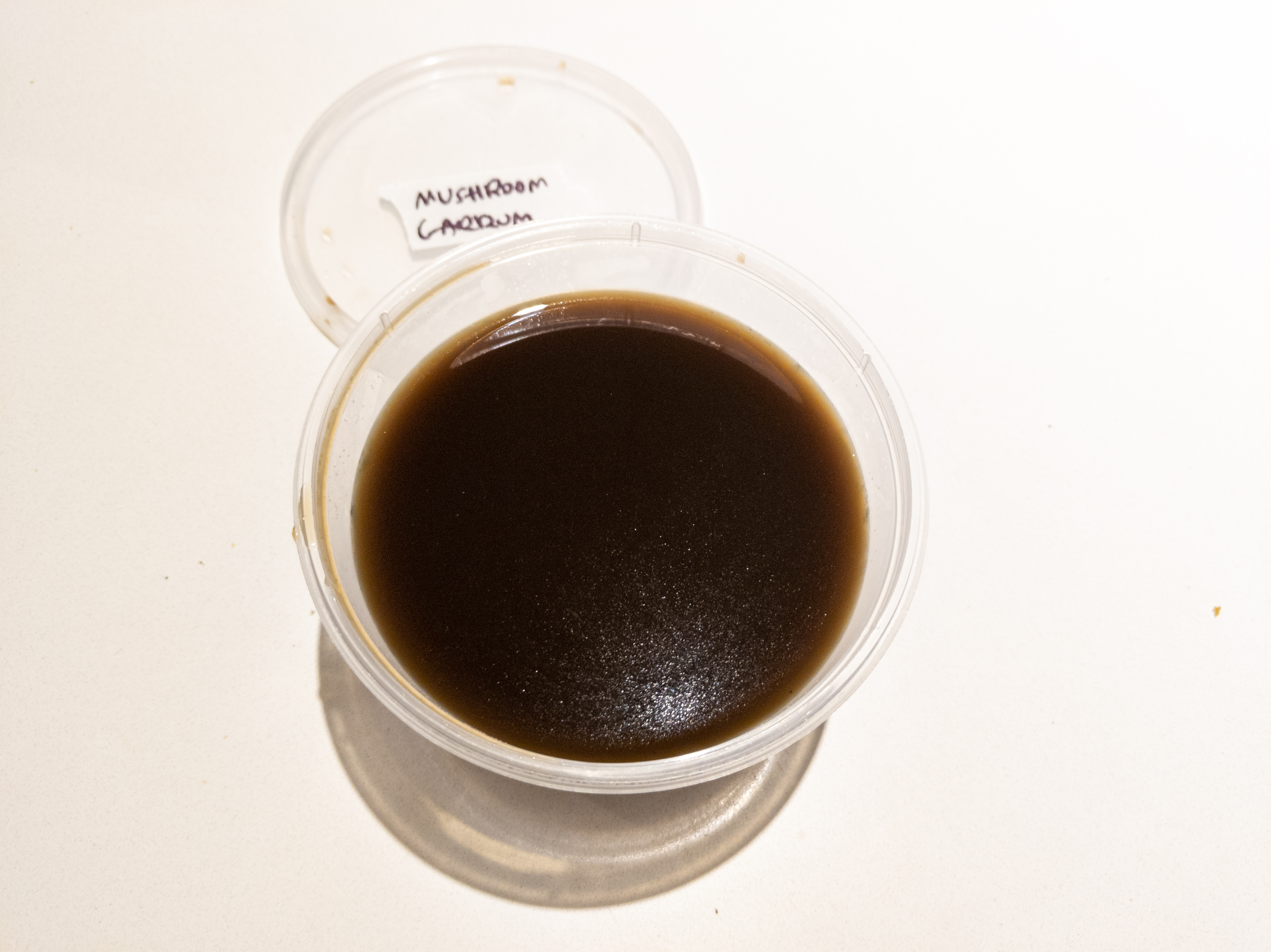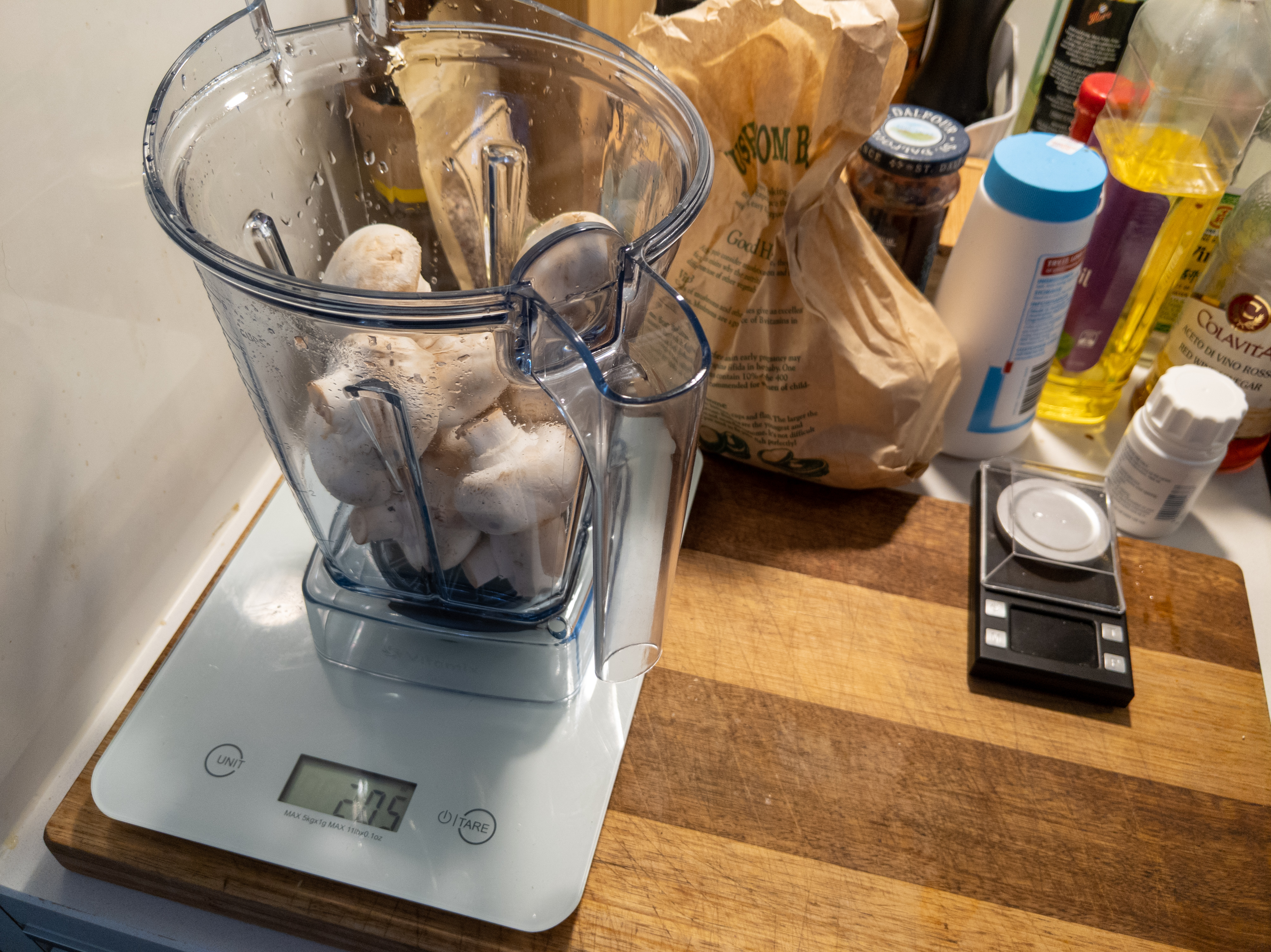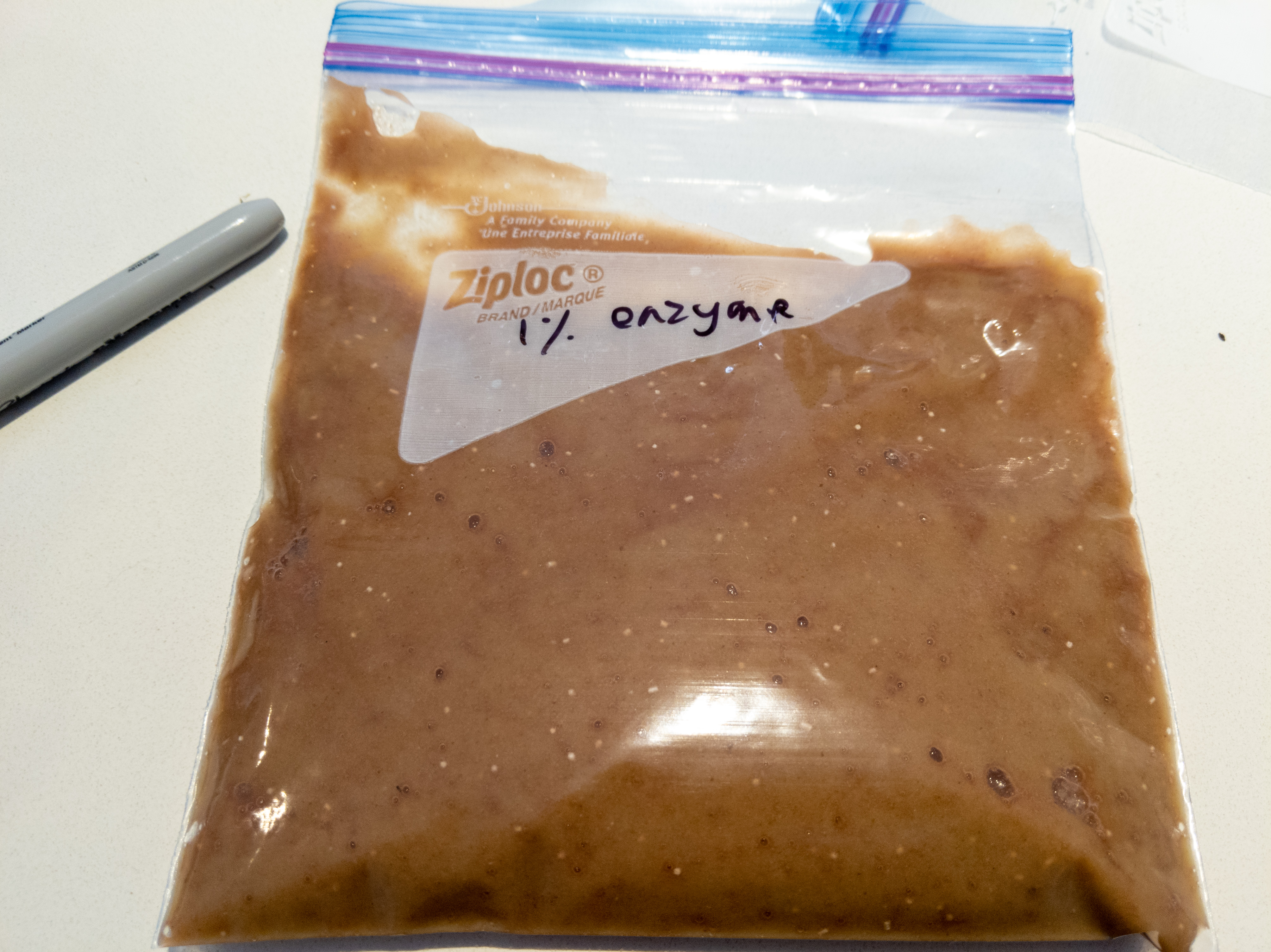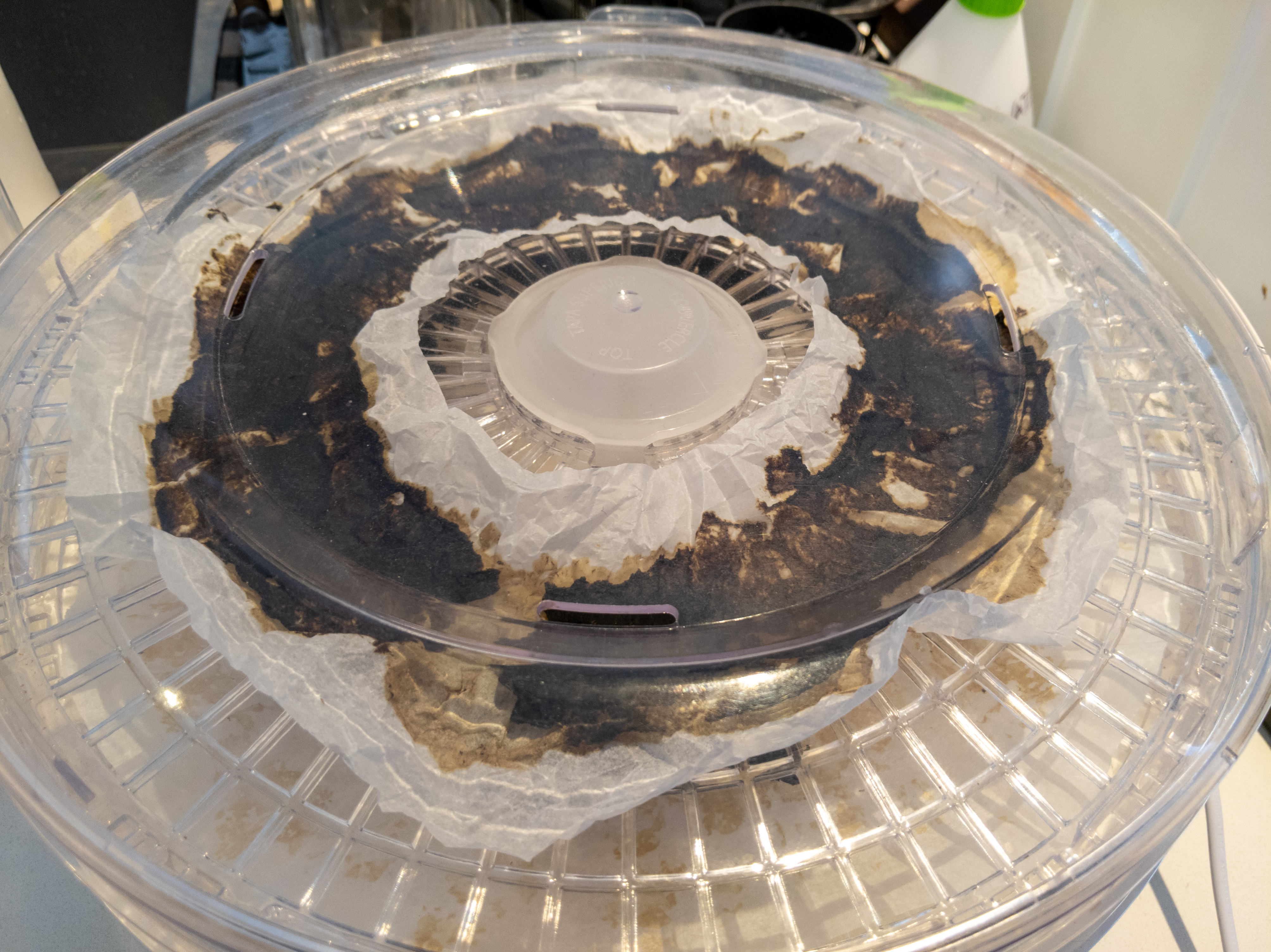Experiments in mushroom garrum
Background
Garrum is the name of the fermented fish sauce that was produced in ancient Greece, Rome and Carthage (to name a few). Similar to today’s mass produced fish sauce, it was salty and fishy, while being very rich in umami. Traditional garrum gets its delicious savory flavor from the breakdown of proteins in fish (and other seafood) into glutamates. Glutamates are interpreted by the tongue as being delicious, because they tend to indicate the presence of proteins that we need to live. Ancient civilizations didn’t know what an enzyme was or how to purify them. What they were using were the natural enzymes found in the digestive tracts of fish to break down their own proteins. These garrums use very high salt percentages (18-20%) which allowed them to safely ferment in the hot sun. Traditional garrums can take 12 months or more to fully mature.
The seminal Noma Guide to Fermentation took garrums in a completely new direction. Instead of just using fish, the Noma book suggests making garrums out of bee pollen, yeast, beef, chicken wings and insects. Just about anything with protein can be made into a delicious and unique garrum. In the Noma book, Zilber and Redzepi trade the protease enzymes found in sea creatures for the protease enzymes produced by the fungus koji. These garrums have lower salt percentages (12%), but have to be incubated at high temperatures (60C) to keep them safe. The higher temperature also serves to increase the activity of the protease enzymes, which allows this style of garrum to happen in 3 months instead of 12.


Some finished mushroom garrum I made a few days ago
With that background out of the way, we arrive at the subject of this post: 3 hour garrums. Preston Landers has adapted and honed a Noma technique for creating garrums in a fraction of the time they usually require. I’ll leave the details of the technique to Preston in his blog post introducing the technique. But the gist is that he’s managed to cut the time for making garrum from 3+ months to 3 hours by utilising a dietary supplement that contains huge amounts of the protease enzymes we need for breaking down protein.
To say this is revolutionary is a bit of an understatement.
Firstly, we can now produce garrums in 1/700th of the time of the already ‘quick’ 3 month Noma method. This massively increases the amount of experimentation we can do, because we can go from idea to finished product in an afternoon.
Secondly, it democratises garrum production by lowering the amount of technique and equipment required. Noma style 3 month garrums require koji, and an incubation setup. You can grow koji at home, but it’s tricky to get right. It’s a whole project to its self. For incubation, you need to keep the 3 month garrum vessel at 60C for the entire time. Also doable at home, but again, potentially complex.
For these 3 hour garrums, all we need is a sous-vide circulator, and the supplement that contains the enzymes. I was able to find the enzymes at my local chain pharmacy, and sous-vide circulators are increasingly becoming part of many home cooks’ cupboards.
Preston deserves incredible praise for his ingenuity and lateral thinking in bringing this technique to the masses. I’m incredibly excited for the flavors and dishes that people will be able to create by applying this technique in new and interesting ways to novel ingredients.
Preston has covered the original method as well as some of his other quick garrum experiments on his blog, but I wanted to add some of my own data to the mix. For my experimentation, I chose mushrooms.
Mushroom garrum
Mushrooms are naturally rich in umami, but also contain small amounts of protein (roughly 3%). I decided to see what would happen if I applied the quick garrum process to button mushrooms. I decided on button mushrooms for these tests, because apparently they have the highest proportion of protein among mushrooms (according to the sources I could find).
The short story is that making garrum from mushrooms works, and it’s delicious. Follow the recipe from Preston’s blog, with 50% added water (to help puree the mushrooms), and 1% of the mushroom weight in enzyme. The result is richly mushroomy, but with a crazy-strong umami hit. It’s the ultimate mushroom condiment, and I look forward to using it to boost mushroomy flavor all over the place.
The longer story is that as I experimented with my mushroom garrums, I discovered some interesting aspects of this technique that may have wider implications.


Weighing out some mushrooms to make some garrum
Finding 1: enzyme percentages allow you to trade time for cost
The enzymes that I purchased are fairly cheap, but they’re not free. I decided to make a really large batch of garrum, and as I was emptying out the enzyme from the gel caps, I got a little apprehensive about how much enzyme I was using. If it didn’t work, I would have basically wasted $20. Definitely not the most money I’ve spent on a failed food project, but not ideal. However, based on my knowledge of how enzymes work, I surmised that I could probably just halve the enzyme concentration and double the amount of time to achieve the same result.


Weighing out enzyme on my milligram scale
I ran a test to determine whether this holds for garrums, and my results indicate that it does. I made two batches of garrum of identical size, with identical process, except for the enzyme concentration and the time I kept them at 60C. One batch got 0.5% of the mushroom weight of enzyme, and was incubated for 6 hours. The other batch got the standard 1% enzyme and 3 hour incubation.


The bagged up mushroom puree, with 1% enzyme
The result was identical to my palate.
The reason this works is that in the mushroom garrum, the amount of protein is far in excess of the protein-breaking-down ability of the enzymes. This means that the amount of enzyme is the limiting factor. At a given temperature and pH, an enzyme converts inputs to products at a fixed rate, if the input is in excess. So doubling the amount of enzyme will make things go twice as fast, and halving the amount of enzyme will make things take twice as long.
This finding was relatively obvious given an understanding of biochemistry, but it’s a good one to have confirmed. It means that you can make larger batches with less enzyme, if you’re willing to wait longer. Being able to make a batch of garrum in 3 hours is amazing. But being able to choose where you want to sit on the cost-time axis is nice as well.
Finding 2: roasting mushrooms doesn’t leave much protein for the enzymes to work on
Preston is also a ramen genius, and has a recipe for a roasted mushroom stock that he uses as part of his thiccc vegan ramen recipe. We both thought it would be interesting to see whether combining the two techniques (roasting mushrooms in the oven overnight, and quick garrum) would lead to interesting and delicious results.
One of the downsides of this 3 hour garrum technique is that it happens so quickly that it doesn’t produce any maillard flavors. The Noma and traditional garrums happen for such long times that even 60C is enough to produce significant darkening of color and development of roasty flavors. This makes traditional and Noma quick garrums more complex, at the expense of taking a very long time as well as not preserving the taste of the original ingredient quite as well. However it’s nice to have options, and being able to add this roasted flavor through other means (and means that only take 8 hours) would be nice.


The bagged up mushroom puree in my incubation bath. The big jar is full of a more traditional yeast garrum
So does this combination of techniques produce tasty results? Sadly, not really.
I made a batch of Preston’s roasted mushrooms, and added enzyme against the total weight, adding 50% water to help it puree. In the interests of transparency, I added 0.5% by weight of enzyme and incubated for 6 hours, but as we learned above, this is equivalent to 1% by weight for 3 hours. The result didn’t taste any different from the regular roasted mushroom juice. It’s possible that there was a touch more umami, but it definitely wasn’t the umami bomb that is the regular mushroom garrum.
In other words, it’s not worth it.
What we think happened here is that the roasting overnight in the oven essentially converted all of mushroom proteins into delicious roasted mushroom flavors. At that point, there isn’t any protein for the protease in the enzymes to work on. You’ve already ‘spent’ all of your proteins on making roasted mushroom flavors. You can’t have your cake and eat it too.
This is an interesting and unexpected result. You expect some sort of breakdown of the raw materials after roasting for 8 hours, but I wouldn’t have expected all of the protein to be broken down.
What this points to more broadly is that combining very long roasting techniques with 3 hour garrums may not produce good results. That said, further testing is probably required. Some foods may have such high protein contents that roasting for 8 hours doesn’t break down all of the protein, leaving lots to be broken down by the enzymes. Some foods may have proteins that don’t break down at such low temperatures, with their roasted flavors instead coming from other breakdowns (of starches, sugars, etc.). A study of the literature would probably be of help here, but as always, if it isn’t industrially relevant then there may be no data.
What I can say is that for mushrooms I don’t think it’s useful. A quick sear of the mushrooms would probably produce a much better result, though the difficulty there is getting a good sear without using any fat (fats break down in to bitter compounds using the enzymes employed in this technique).
Finding 3: the leftovers from the mushroom garrum aren’t worth saving
My final test was to try and make use of the mushroom pulp that was leftover after squeezing out all of the mushroom garrum. The usual strategy with these sorts of fermentation solids is to dehydrate them and use them as a tasty powder.


The mushroom leftovers dehydrating
I tried dehydrating these mushroom solids and then powdering them in a spice grinder. The result was a powder that tastes very gently of mushrooms, but not enough to really be worth it. This isn’t to say that it’s not worth dehydrating any of the 3 hour garrum solids, but for my palate, it’s not worth it for mushrooms.
I’m not totally sure why these solids didn’t taste like much. It’s possible that because the garrum is only salted after straining, these solids are lacking flavor simply because they’re not salted. I tried using the powder as a seasoning for popcorn along with some salt, but the mushroom flavor really didn’t come through.
The other possibility is that the enzymatic process is so efficient that there simply isn’t much left in these solids to provide flavor. Since the enzymes we’re using contain protease, lipase and amylase, the breakdown of anything treated with them should be fairly complete from a nutritional perspective. Since our taste buds are tuned to find nutritionally relevant foods, I think it’s reasonable to assume that things that can’t be broken down by protease, lipase or amylase probably don’t taste like much. If we can’t get any nutrition from them, natural selection is unlikely to have retained mutations in our taste buds that give these nutritionally void compounds tasty flavors.